Wi-Fi 7 was certified by the Wi-Fi Alliance in the first days of 2024, paving the way for faster and more reliable internet. It’s set to take over for Wi-Fi 6 and 6E, and router manufacturers have already hit the market with some Wi-Fi 7 routers to accommodate the (so far) limited selection of devices supporting this new standard.
Wi-Fi 7 promises several improvements over its predecessor, notably opening up wide 320MHz channels in the 6GHz band for improved throughput, adding multi-link operation (MLO) to allow devices to communicate over multiple frequencies at once for improved latency and performance, and overall improving efficiency and data transfer capabilities.
There are already some great Wi-Fi 7 routers that deliver a solid single point of access, but there are also Wi-Fi 7 mesh routers with multiple nodes that greatly improve range and flexibility. Mesh systems are usually recommended over a standard router and range extender combo, save for situations where price is an issue. If you’re interested in upgrading your network to mesh and want to check out the latest Wi-Fi standard, we’ve compiled this list of the best Wi-Fi 7 mesh routers you can buy now.
Our favorite Wi-Fi 7 mesh routers in 2024
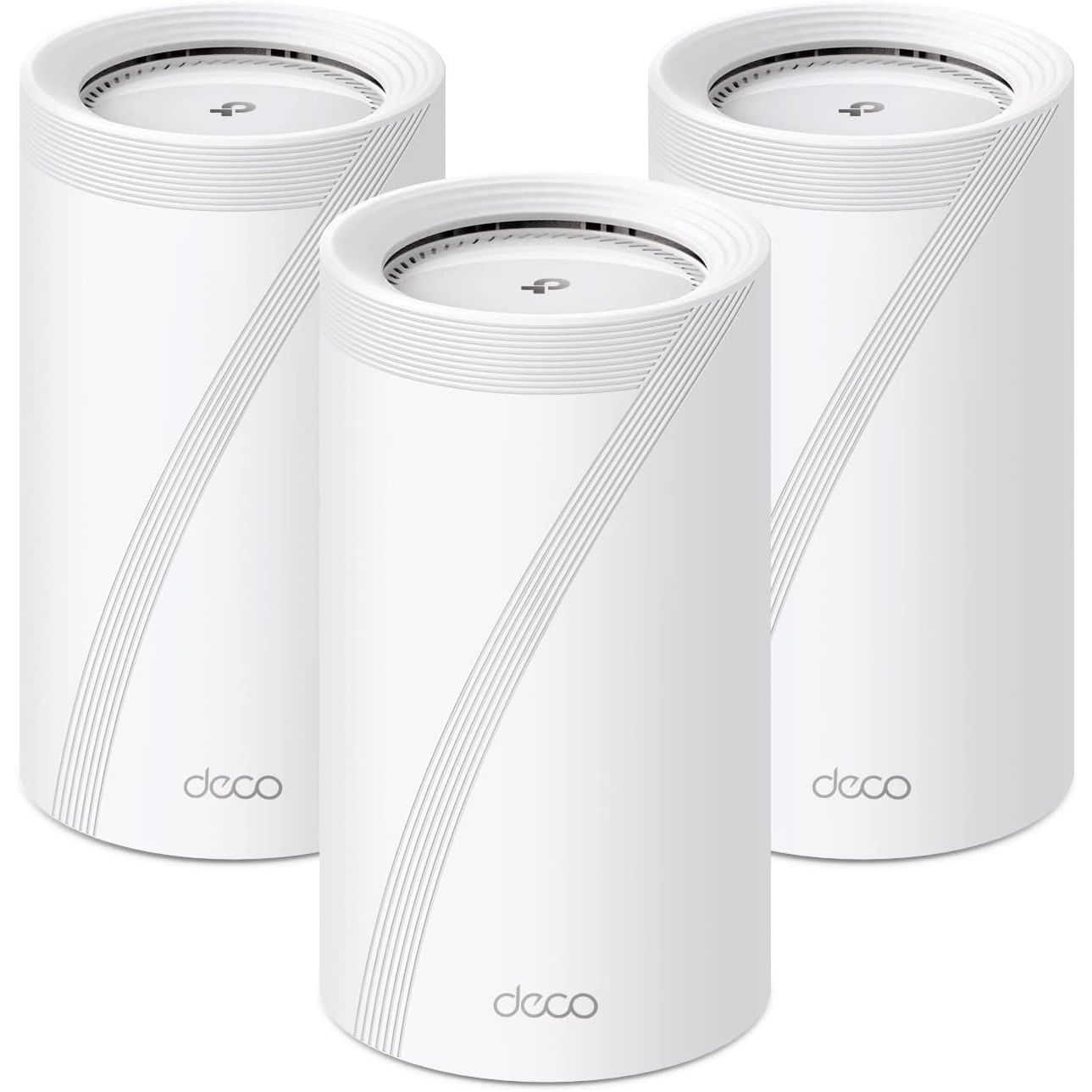
Best overall
TP-Link Deco BE85
Great for most people
TP-Link’s Deco BE85 was the first Wi-Fi 7 mesh system to hit the market, and it holds strong as the best option for most users. It’s easy to set up and manage, it offers strong performance and enough range for a huge home or office, and it’s priced competitively.
- Strong wired and wireless performance
- Wired/wireless simultaneous backhaul
- Easy to set up, many customizable features
- Can still find cheaper Wi-Fi 7 mesh kits
TP-Link has long been a leading name in the networking space, and it was the first to offer a Wi-Fi 7 mesh router. The Deco BE85 is mainly available in two- and three-piece kits, with prices set at about $1,000 for the former and $1,500 for the latter. That might seem like a lot (and it is), but it’s priced competitively compared to other mesh options. Only the Linksys Velop Pro 7 and Netgear Orbi 770 are more affordable.
The Deco BE85 is capable of theoretical throughput hitting 1,376Mbps on the 2.4GHz frequency, 8,640Mbps on 5GHz, and 11,520 on 6GHz, giving you plenty of performance for everything from streaming to gaming. Each unit has two 2.5Gbps WAN/LAN ports, one 10Gbps WAN/LAN port, 10Gbps WAN/LAN and SFP+ combination, and a USB-A 3.0 port for adding removable storage or connecting wired devices. This also allows the Deco BE85 wired backhaul capabilities, which prevents wireless network congestion and slowdown from the nodes relaying information back and forth. The Deco BE85 is even capable of simultaneous wired and wireless backhaul.
Like all true mesh systems, the Deco BE85 offers a seamless experience where your devices automatically switch between nodes for best performance. And it wouldn’t be 2024 without some AI improvements that keep your network as efficient as possible. The Deco BE85 is easy to set up (as long as you don’t mind using the Deco app), there are many features to delve into, and it’s comfortable acting as a centerpiece in your smart home.
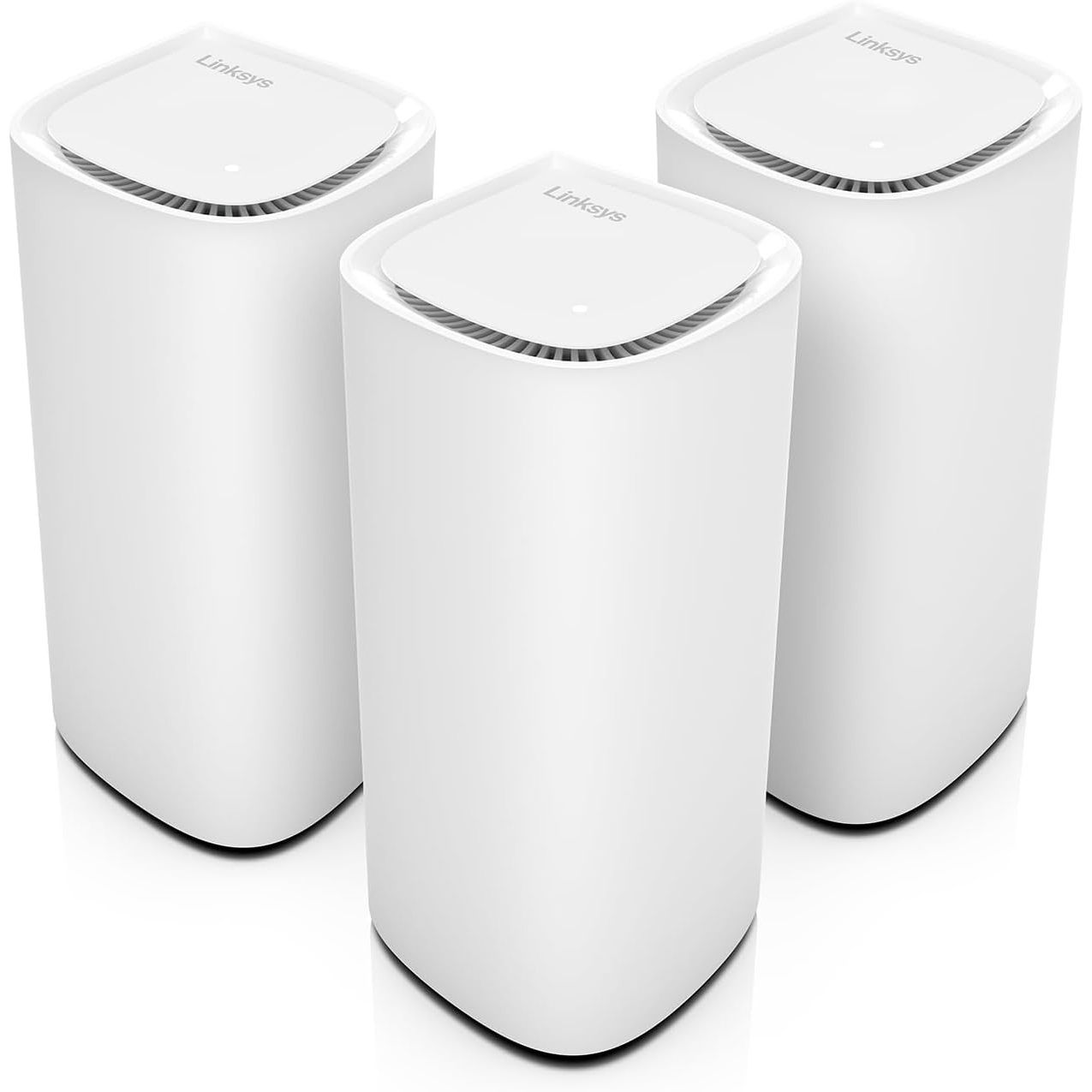
Best value
Linksys Velop Pro 7
Start with one node and build from there
$560 $900 Save
$340
The Linksys Velop Pro 7 is a relatively affordable mesh system that should suit anyone looking to expand range without the need for particularly high-end specs or throughput. You can start with one unit and work your way up, but the best value lies in the three-pack of nodes.
- Relatively affordable compared to the competition
- Simple tower design won’t clash with decor
- Easy to set up and works reliably
- Wired and wireless performance falls behind competitors
- No USB ports
The Linksys Velop Pro 7 is more affordable than our other top picks, and for many people that will be enough to jump into the new standard. A single unit costs about $300, but you can find a two-pack for about $450 and a full three-pack for about $600. If you’re looking to start with a full three-router setup on the cheap, this is the way to go. Each node can act as a standalone router, so you can also start with one unit and work your way up as needed.
Theoretical throughput across frequencies isn’t as impressive as our top pick. With theoretical throughput advertised as “over 10Gbps” you can expect a breakdown of something like 0.5Gbps on the 2.4Ghz frequency, 4.3Gbps on 5GHz, and 5.7Gbps on 6GHz. The Velop Pro 7 also lacks a 10Gbps port, offering a maximum of 2.5Gbps on the WAN port and otherwise 1Gbps for the four LAN ports (which means 1Gbps is the limit for wired backhaul).
Power users or anyone concerned about maximizing performance will likely want to look elsewhere for these reasons, but those who want to extend range and don’t particularly need the best performance possible should still consider it for the money saved. It’s easy to set up, it’s reliable, and the tower design doesn’t get too fancy.
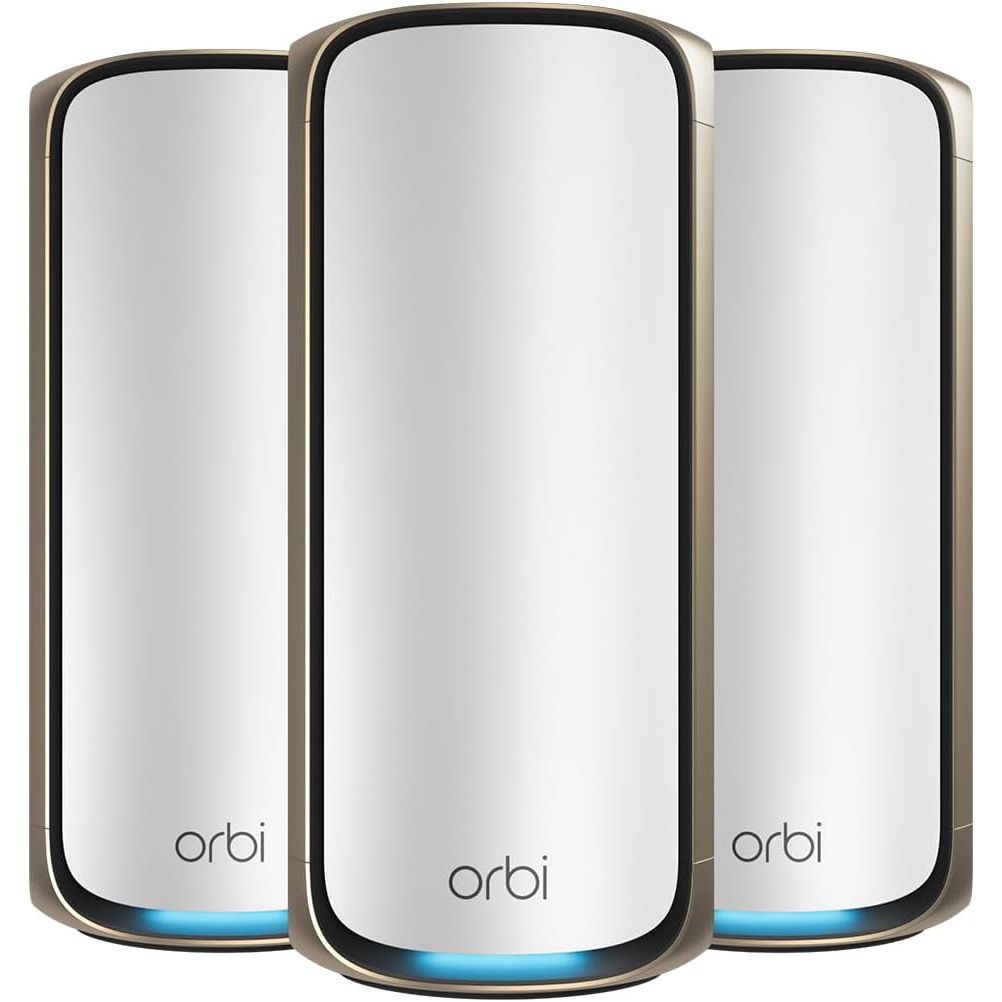
Premium pick
Netgear Orbi RBE973S
High-end features at a high price
Netgear’s Orbi 970 series is a solid choice for power users and gamers who want to maximize performance and range. It’s crazy expensive, and it wouldn’t hurt for Netgear to add in some otherwise subscription-based features for free when you’re spending this much on hardware.
- Huge range, strong performance
- Dedicated 5GHz wireless backhaul band
- Easy setup
- No USB connectivity
- Prepare to pay more for advanced features
- Crazy expensive
Netgear’s Orbi 970 is one of the most expensive options on the market, with the RBE973S three-pack (main router and two satellites) coming in at about $2,300. You can also get a two-pack kit with router and one satellite for about $1,700, while a single additional satellite costs $900. Consider it overpriced, but those who want great range and high-end performance might be tempted to spend big.
Netgear claims the full three-unit system can cover up to 10,000 square feet, with each extra satellite adding about 3,000 square feet of coverage. It can also handle respectable theoretical throughput with the 2.4GHz frequency hitting 1,147Mbps, 5Ghz hitting 5,765Mbps, and 6GHz hitting 11,530Mbps. There’s also a 5GHz band set aside for dedicated backhaul, meaning you don’t absolutely have to rely on wired backhaul for better performance (though it is certainly still available).
The primary router includes four 2.5Gbps LAN ports, one 10Gbps LAN port, and one 10Gbps WAN port, though it lacks USB. Each satellite has two 2.5Gbps LAN ports and one 10Gbps LAN port for fairly robust connectivity. Setup is straightforward through the Orbi app, and it has a decent amount of settings and features to play around with. However, some of the more advanced features like Smart Parental Controls and Netgear Armor require paying extra for a subscription. That seems like a bit of an overreach when you’re already spending thousands on your network hardware.
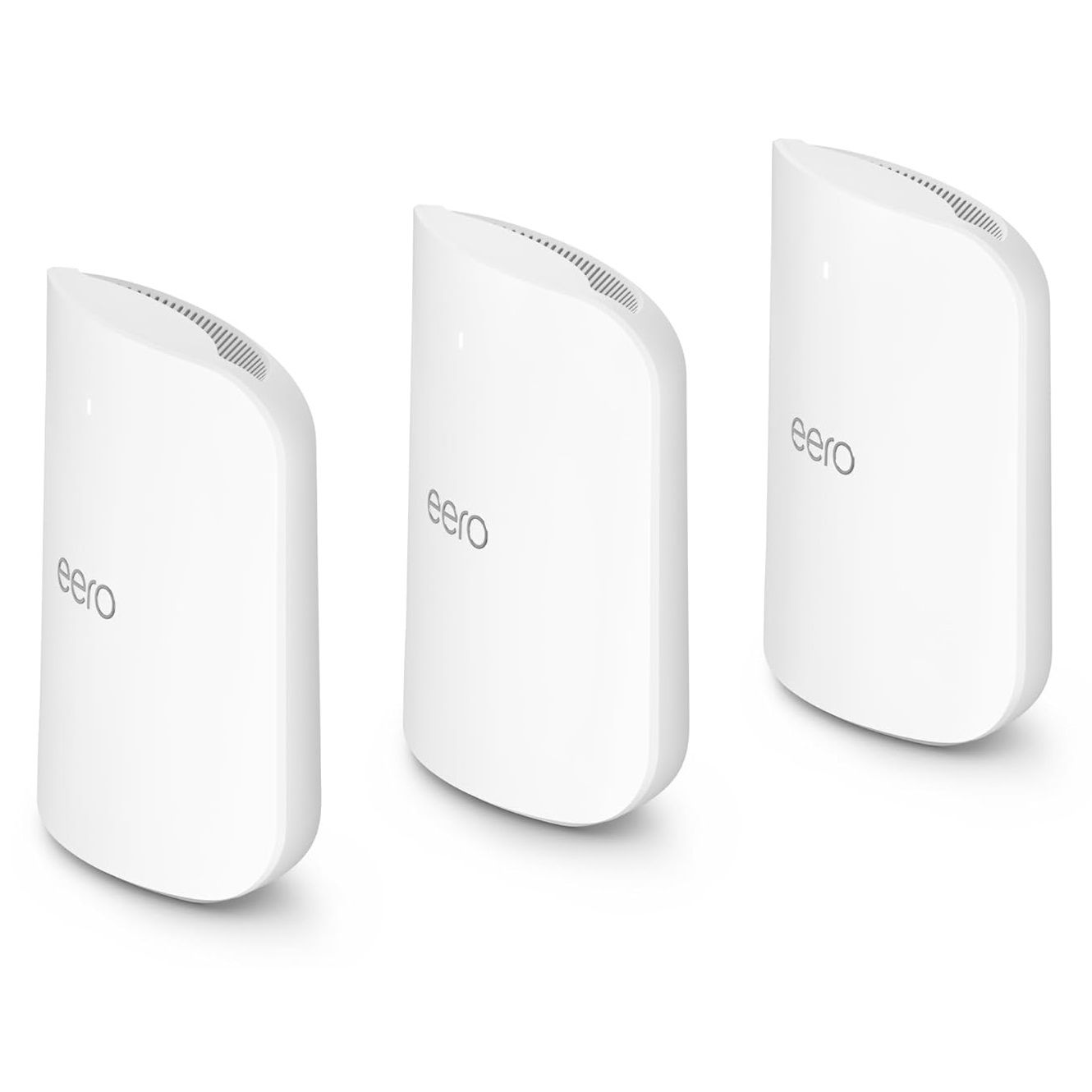
Sleek design
Amazon eero Max 7
For those already in the eero ecosystem
Amazon’s eero Max 7 isn’t an option I’d recommend to everyone, at least until the price comes down to beat the superior Deco BE85. However, those who are already deep into the eero ecosystem will be right at home with their new Wi-Fi hardware.
- Quick and easy setup through the eero app
- Love the sleek design
- Fits right into the eero ecosystem
- Many features hidden behind a paywall
- Pricier than the Deco BE85
- Port selection not as impressive
Amazon’s eero Max 7 shares a lot of similarities with our top pick, the TP-Link Deco BE85. However, the eero Max 7 is more expensive. A single eero Max 7 unit costs $600, a two-pack hits $1,150, and a three-pack costs $1,700. That’s $200 more than the Deco BE85’s three-pack. Amazon’s router also comes up lacking in some key areas.
The eero Max 7 has no USB-A port, its 2.4GHz band tops out at 688Mbps theoretical throughput (instead of 1,376Mbps in the Deco), and it lacks the SFP+ combination port ability. I’d recommend the Deco BE85 to most people for these reasons alone.
Where the eero Max 7 makes a case for itself is in the home or office of someone already embedded in the eero ecosystem. Many of the best features are reserved for an eero Plus subscription plan, and you absolutely need to use the eero app for the router to function.
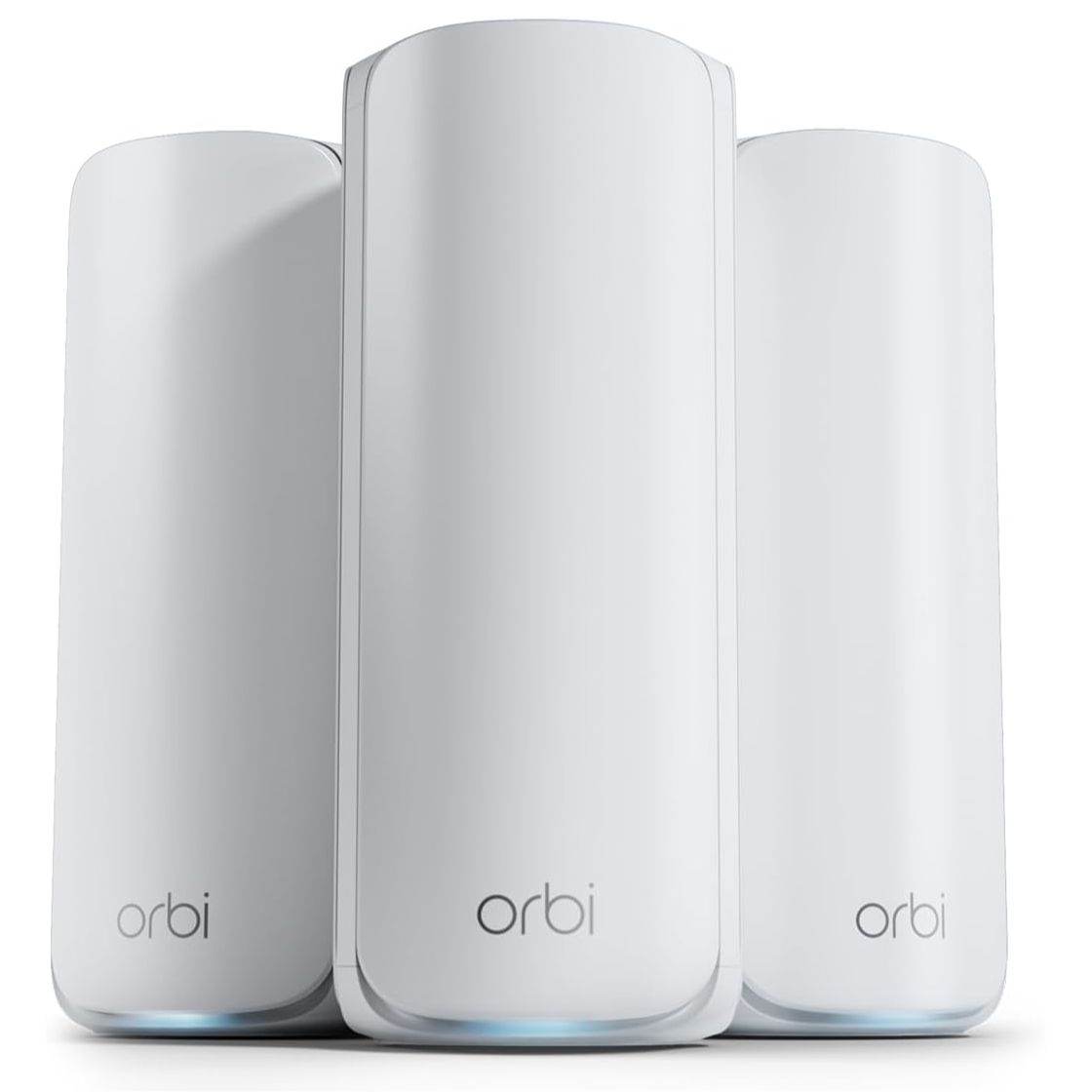
King of coverage
Netgear Orbi 770
Fully featured solution for large homes
With up to 8,000 square feet of coverage from three nodes, the Netgear Orbi 770 Series is serious equipment meant for palatial homes and growing small businesses. Offering tri-band Wi-Fi and the newest Multi-Link Operation (MLO) mode, each node has dual LAN ports and a bandwidth of 10.8 gigabits.
- 8000 sqft of coverage from the triple pack
- Easy to setup using phone app
- MLO technology
- Expensive
- Router only supports 2.5GbE on WAN
The Netgear Orbi 770 series is part of a unique group of mesh hardware that offers an extensive wireless range and bandwidth. These devices are ideal for large homes or those needing extra router power to overcome local interference.
Rated at BE110000, that’s 10.8Gbps of theoretical bandwidth divided between 2.4GHz, 5GHz and 6GHz channels. As the nodes each have two 2.5GbE LAN ports, a wired backhaul can be used, freeing all the wireless bands to support connected clients.
There are two snags with the Netgear Orbi 770. The first is that, like many Wi-Fi 7 solutions, it isn’t cheap. Netgear slightly compounds the high cost by selling the router with satellites only in a dual or triple pack. Therefore, adding just the router to start isn’t an option. Thankfully, you can buy the satellites individually.
Also, the router’s 2.5GbE WAN port isn’t fast enough for lucky people with even faster connections. And, common to many Netgear routers, some of the most desirable security features are protected behind a subscription paywall.
If you can afford nearly a thousand dollars, get the triple pack, which includes two satellites. In that case, the Netgear Orbi 770 Series is a feature-rich option that is easy to deploy using the web or smartphone application, and it can effectively service a large property.
Getting the right Wi-Fi 7 mesh router for your network
Wi-Fi 7 and its list of improvements is not the final answer to single-point wireless networking, and users with a large area to cover with a reliable signal might be searching out ways to expand their network. Adding an extension is an option, though range extenders usually have a much longer list of drawbacks compared to a proper mesh network. A mesh network provides multiple nodes with greatly improved range and flexibility, allowing you to move about your space and operate normally without having to worry about getting the perfect signal, but at extra cost.
Wi-Fi 7 is still in its infancy, and the supporting router hardware is limited. Also in short supply are compatible devices. Samsung’s Galaxy S24+ and S24 Ultra are notable high-end products with Wi-Fi 7 support, but the majority of devices work with, at best, Wi-Fi 6 or 6E. You can check out our guide to Wi-Fi 7 for a more detailed look at all the differences between standards and the implications of choosing one over another.
Those looking to upgrade to Wi-Fi 7 with a mesh network should check out TP-Link’s Deco BE85. It’s undeniably expensive, but offsets the outlay with a strong set of features, and it has the range and performance to suit most people’s networking needs.
You can spend less on the Linksys Velop 7, but you’ll miss out on some great features. You can also spend more on the Netgear Orbi 970 to land some extra range and performance, but the elevated price is beyond reasonable for most people.

Best overall
TP-Link Deco BE85
TP-Link’s Deco BE85 brings strong performance and respectable features in a competitively-priced package. It should be the best option for most users looking to upgrade to Wi-Fi 7 in the early days of adoption.



